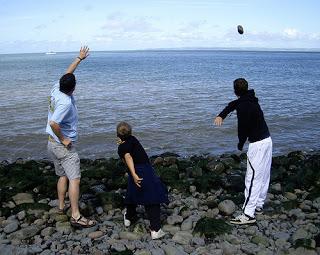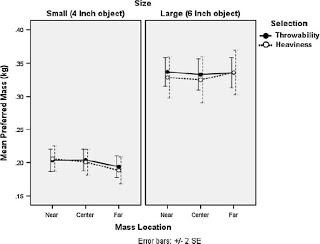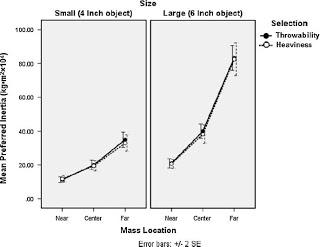 Previous work has established that people with throwing experience can perceive the affordance of 'throwability'. If you let these people heft objects with a range of sizes and weights, they will confidently select the one they think they can throw the farthest, and they tend to be correct. It's a very natural task, one you have probably done yourself on a beach or lakeside looking for stones to throw into the water.
Previous work has established that people with throwing experience can perceive the affordance of 'throwability'. If you let these people heft objects with a range of sizes and weights, they will confidently select the one they think they can throw the farthest, and they tend to be correct. It's a very natural task, one you have probably done yourself on a beach or lakeside looking for stones to throw into the water. This is only the first, and relatively easy step in any ecological task analysis. Once you've identified an affordance property and established that people are sensitive to it, you need to identify the information supporting this perception. For throwing, this has not been done, and while the paper I'm reviewing here doesn't solve the problem, it does rule out a highly likely contender for the source of the information that has implications for a lot of other research.
Previous research (Zhu & Bingham, 2011) had identified that the objects people select to throw all feel equally heavy, regardless of size. This suggests that people are using the felt heaviness of the objects to judge throwability. 'Felt heaviness' is a function of both size and weight, and produces the size-weight illusion where larger objects must be heavier to feel equally heavy. Zhu & Bingham (2011) gave people balls of different size and weight and, for each size, had people judge which weight they could throw the farthest. They then used one of these objects as the comparison object, and asked people to find which larger ball felt equally heavy from the other size sets. People chose the ball within each set that they had also judged to be maximally throwable. Across sizes, balls that afford maximum distance throwing feel like they are equally heavy; the size weight illusion is not an illusion, it's about throwing.
So how do we perceive heaviness? It's not simply weight, size matters; so the question really is, what property of the object are we perceiving when we judge heaviness? The best suggestion in the literature comes from research on dynamic touch, which suggests that the proprioceptive perception of heaviness is not about the object property 'weight', it's about the object property rotational inertia. There is a wealth of evidence that judgments of heaviness vary with this property, which is the resistance the object offers to being moved in a rotational movement (say, flexing your arm at your elbow; see Amazeen & Turvey, 1996).
So we now have a couple of pieces; can we tie them together? People seem to be using felt heaviness to judge which objects they prefer to throw. Felt heaviness seems to be about the rotational inertia of the object. Zhu, Shockley, Riley, Tolston & Bingham (2012) therefore tested the hypothesis that the key property of the object driving the perception of the affordance for throwing is rotational inertia.
The authors had competent throwers hold balls in their hands that varied in size, weight and rotational inertia. The latter is manipulated by varying the way the mass of the ball is distributed; shifting more of the mass off center away from the axis of rotation increases the rotational inertia (i.e. makes it harder to rotate). People then hefted the objects by moving their wrists up and down while holding the ball.
After hefting a range of weights and inertias within a given size, people judged which object they thought afforded throwing to a maximum distance. Then, people went through the size sets again. This time, they looked for a ball that felt equally heavy to a comparison object, which, unknown to them, happened to be the ball for that size they had previously judged to be maximally throwable.
The question was this: what objects did they pick, and what properties did these objects all have in common - size, weight, or inertia?

Figure 1. Judgments sorted by object size and weight

Figure 2. Judgments sorted by size and rotational inertia
Figure 2 shows the rotational inertias of the selected objects. Remember, these objects were judged as equally heavy and all affording throws to a maximum distance. However, the rotational inertias varied, and varied differently for the differently sized objects.The overall pattern of results is that 1) perceived heaviness is the basis of the judgments of throwability but 2) rotational inertia is not the basis of perceived heaviness or throwability. Without knowing the property being perceived, we can't (yet) begin to identify the information about that property. The hunt continues!
Failure to replicate Amazeen & Turvey (1996)
The fact that rotational inertia is not the property underpinning perception of throwability is surprising, but that's how things go. What's more interesting is that rotational inertia, for the first time, was not the property underpinning perception of heaviness. Why did this otherwise robust result not replicate here?
The main difference is in the objects used. Previous work typically has people wielding long, weighted rods over varying inertia. The resulting inertias (and variation in inertias) are quite large. In contrast, hefting these spheres, all graspable in a hand, produces a small range of smaller inertias. Geoff has suggested to me that the most likely explanation is that the inertias of these spheres is below threshold (although no one has ever done any psychophysics on dynamic touch to establish what the thresholds for rotational inertia are).
The consequence of this result is that because of this threshold issue, rotational inertia can't be the property people are perceiving in this task, and, contrary to previous claims, it can't be the property that explains all perception of heaviness.
Summary
People can heft objects and perceive the affordance property throwability. Until we know the relevant object property, however, we can't identify the candidate information variables that property produces and empirically establish which variable people use as information to perceive this affordance. We know that people perceive the affordance in terms of felt heaviness, and that people can select the specific felt heaviness that corresponds to an object that affords throwing to a maximum distance. However, we do not yet know what property of spherical objects determines felt heaviness, and this study rules out the obvious contender, rotational inertia. It's back to the drawing board for throwing, to identify the next candidate relation between size and weight that people are perceiving.
References 
Zhu, Q., & Bingham, G. P. (2011). Human readiness to throw: the size–weight illusion is not an illusion when picking the best objects to throw. Evolution and human behavior, 32(4), 288-293. Download My blog post
Zhu, Q., Shockley, K., Riley, M., Tolston, M., & Bingham, G. (2012). Felt heaviness is used to perceive the affordance for throwing but rotational inertia does not affect either Experimental Brain Research DOI: 10.1007/s00221-012-3301-7

